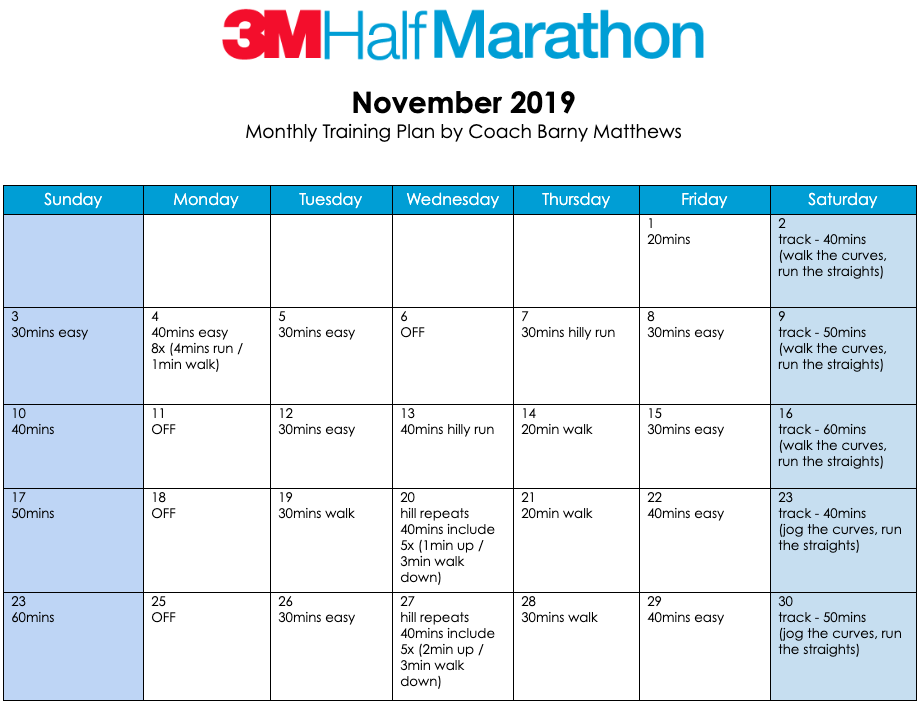Prepare for a half marathon with these 7 types of runs
Whether this is your first half marathon or your 10th, make sure these 7 types of runs are a part of your training. This breakdown can explain to beginners what their workout might specifically call for. These descriptions are helpful for veterans because it reminds them of what they need to focus on during their next run. Whatever your next type of run is, make sure you foam roll afterward to speed up your recovery.
Long
This is a run that is longer than any of the other types of runs. Long runs have many benefits: builds muscle/heart strength, improves endurance, and teaches the body to burn fat rather than glycogen as a fuel source. They differ based on your current fitness level and the overall distance that you’re trying to achieve (like 5K or a marathon). Most training plans call for no more than one long run per week. Follow this long run recovery timeline to feel better faster.

The Wilke Rd. hill workout will make you a stronger runner!
Hill repeats
Running hill repeats increases leg strength, improves fitness, and uses the muscles of the legs, arms, and core in ways that are different than running on flat surfaces. Hill repeats help improve running economy, which translates into less energy expended over the course of a long-distance race. Start from the bottom of the hill, choose a destination point at the top of the hill and sprint up the hill to get there as fast as you can. Jog back to your starting point and repeat. The distance will be much shorter than your usual run, but the high-intensity sprint, as well as the incline, will make this challenging. Check out these Austin locations and try the recommended workouts!
Progression
Progression run is a run with a structured pace that increases from beginning to end. The distance and pace will vary based on your specific training goals. This type of run is good for improving your running stamina, mental strength, and teaching the body to run increasingly faster at the end of a race. It’s also a way to get a run in that is more difficult than the base run but not as intense as other different types of running.
Tempo
Tempo run refers to a “comfortably hard” pace that you can maintain for a longer period of time. It is different than race pace, however. A tempo run (also known as an anaerobic threshold or lactate-threshold run) is a pace about 25 to 30 seconds per mile slower than your current 5K race pace. Basically, when you run, your muscles build up lactic acid, a metabolic byproduct that causes them to fatigue. The intention of a tempo run is to increase your threshold so that your muscles don’t fatigue as fast. This allows you to keep running longer.
Recovery
A relatively short, easy-paced, run performed within 24 hours after a hard session; usually an interval workout or a long run. Easiest training day of the week after rest days. A recovery run is done at an easy pace, “easy” being relative to your fitness level.
[bctt tweet=”Recovery run – relatively short, easy-paced, run performed within 24 hours after a hard session; usually an interval workout or a long run. Easiest training day of the week after rest days.” username=”@3mhalfmarathon”]
Sprints
Sprint workouts mean to run shorter distances at a faster than normal pace with multiple repeats during the workout. Sprint training is essential if you want to increase your speed. It builds strength and power so that you can run faster. Even if you’re a long-distance runner, sprinting is beneficial. Sprints actually help you run longer. They condition your body to be able to handle the distance without fatiguing as quickly.
Interval
Interval training runs are a mixture of low-moderate and high-intensity runs. It incorporates shorter periods of fast, hard runs where you put in more effort, followed by longer periods of jogging or walking. Interval training means that you will alternate between the two. For instance, you’ll run high intensity for one minute, followed by jogging for two minutes, one minute hard, two minutes easy (for a specified amount of time). Pro tip: the intense interval is key and you really need to push yourself to deliver the benefits, which include improving your running efficiency and your ability to maintain higher speeds for longer. It also burns a lot of calories very quickly.
Knowing about these 7 types of runs and their differences is great. But don’t forget you have to add them to your training and complete them too! When you begin training for the 3M Half Marathon, include these 9 tips runners use to see improvements. Reach out on Facebook or Twitter and let us know your favorite run.













